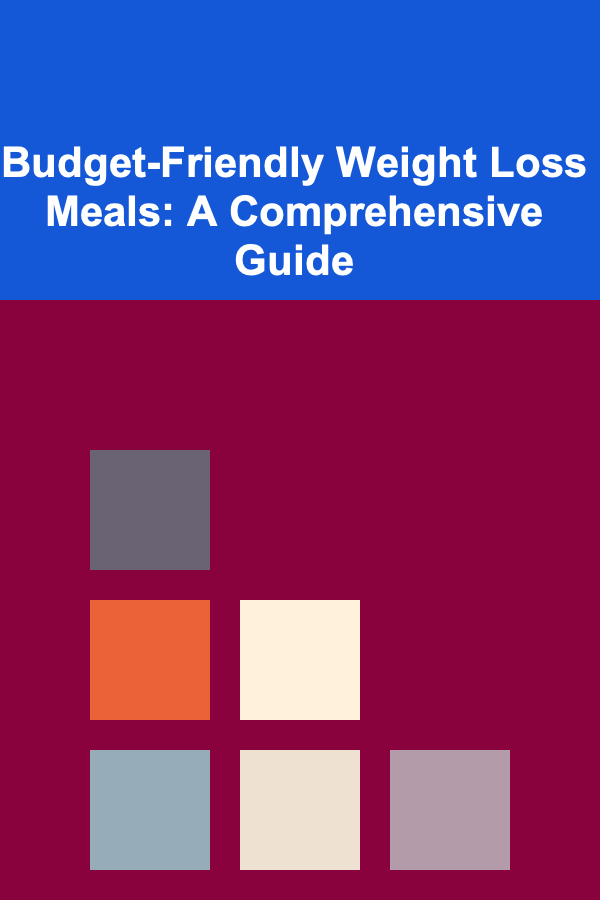
Budget-Friendly Weight Loss Meals: A Comprehensive Guide
ebook include PDF & Audio bundle (Micro Guide)
$12.99$6.99
Limited Time Offer! Order within the next:

Embarking on a weight loss journey can feel daunting, especially when financial constraints are a concern. Many people believe that healthy eating requires expensive ingredients and complicated recipes. However, this simply isn't true. With a bit of planning, creativity, and knowledge of affordable ingredients, you can create delicious and effective weight loss meals without breaking the bank. This guide will provide you with a comprehensive approach to budget-friendly weight loss cooking, covering everything from meal planning and grocery shopping strategies to recipe ideas and portion control tips.
Understanding the Principles of Weight Loss Cooking
Before diving into recipes and strategies, it's crucial to understand the fundamental principles of weight loss cooking. Focusing on these core concepts will empower you to make informed food choices and adapt recipes to your specific needs and preferences.
- Calorie Deficit: The cornerstone of weight loss is consuming fewer calories than you burn. This forces your body to tap into its stored fat for energy. While calorie counting isn't necessary for everyone, understanding the caloric density of different foods is beneficial.
- Macronutrient Balance: Prioritize protein, complex carbohydrates, and healthy fats. Protein helps you feel full and supports muscle mass. Complex carbohydrates (like whole grains and vegetables) provide sustained energy. Healthy fats (like those found in avocados, nuts, and olive oil) are essential for hormone production and overall health.
- Fiber Focus: High-fiber foods, such as fruits, vegetables, and whole grains, promote satiety, regulate blood sugar levels, and aid in digestion.
- Hydration: Drinking plenty of water is crucial for weight loss. Water helps you feel full, boosts metabolism, and aids in the elimination of waste.
- Mindful Eating: Pay attention to your hunger and fullness cues. Avoid distractions while eating and savor each bite. This helps you consume fewer calories and develop a healthier relationship with food.
Strategic Meal Planning for Budget and Weight Loss
Meal planning is arguably the most crucial step in achieving both weight loss and budget control. A well-structured meal plan minimizes impulsive food choices, reduces food waste, and ensures you have healthy options readily available.
- Take Inventory: Before you start planning, check your pantry, refrigerator, and freezer to see what ingredients you already have on hand. This prevents you from buying duplicates and encourages you to use up existing food items.
- Set Realistic Goals: Don't try to overhaul your entire diet overnight. Start with small, manageable changes, such as planning three dinners per week or swapping sugary drinks for water.
- Choose a Planning Method: Use a calendar, spreadsheet, or meal planning app to create your plan. Consider planning for the entire week or just a few days at a time, depending on your schedule and preferences.
- Plan Around Sales and Seasonal Produce: Check your local grocery store's weekly flyer for sales and discounts. Incorporate seasonal fruits and vegetables, as they are typically more affordable and flavorful.
- Theme Nights: Create theme nights to simplify your meal planning process. For example, you could have "Meatless Monday," "Taco Tuesday," or "Soup Sunday."
- Prep in Advance: Prepare ingredients in advance to save time during the week. Chop vegetables, cook grains, and portion out snacks on the weekend.
- Plan for Leftovers: Cook larger portions and repurpose leftovers for lunches or future meals. This reduces food waste and saves you time and money.
Grocery Shopping Strategies for a Tight Budget
Smart grocery shopping is essential for keeping your food expenses low while ensuring you have access to healthy ingredients. Here are some tips to help you maximize your grocery budget:
- Shop with a List: Stick to your meal plan and shopping list to avoid impulse purchases.
- Don't Shop Hungry: Eat a healthy meal or snack before going to the grocery store to prevent cravings and overspending.
- Compare Unit Prices: Pay attention to the unit price (price per ounce or pound) to determine the best value. Sometimes, buying in bulk is cheaper, but not always.
- Buy Generic Brands: Generic or store-brand products are often just as good as name-brand products but cost significantly less.
- Embrace Frozen and Canned Goods: Frozen fruits and vegetables are just as nutritious as fresh and can be more affordable, especially when out of season. Canned beans, lentils, and tomatoes are also budget-friendly staples. Choose options with low sodium and no added sugar.
- Shop in Season: Seasonal produce is typically more affordable and tastier.
- Consider Discount Grocery Stores: Stores like Aldi and Lidl offer significantly lower prices on many items.
- Use Coupons and Loyalty Programs: Take advantage of coupons, rebates, and loyalty programs to save money on your groceries.
- Reduce Food Waste: Store food properly to prevent spoilage. Use leftovers creatively and compost food scraps.
- Bulk Buying (Strategically): Buy items you frequently use in bulk, if you can store them properly and if the unit price is actually lower. Avoid buying perishable items in bulk unless you are certain you will use them before they expire.
Affordable and Nutritious Weight Loss Ingredients
Focusing on these affordable and nutritious ingredients will form the foundation of your budget-friendly weight loss meals.
- Legumes (Beans, Lentils, Chickpeas): Excellent sources of protein, fiber, and complex carbohydrates. They are incredibly versatile and can be used in soups, stews, salads, and as a meat substitute.
- Eggs: A complete protein source that is inexpensive and easy to prepare.
- Oats: A heart-healthy whole grain that is high in fiber and provides sustained energy.
- Brown Rice: Another excellent whole grain that is more nutritious than white rice.
- Chicken (Especially Thighs and Drumsticks): Chicken is a lean protein source, and thighs and drumsticks are generally more affordable than chicken breasts.
- Tuna (Canned in Water): A convenient and affordable source of protein and omega-3 fatty acids.
- Sweet Potatoes: A nutrient-rich vegetable that is high in fiber and vitamins.
- Cabbage: A cruciferous vegetable that is low in calories and high in fiber.
- Carrots: An affordable and versatile vegetable that is rich in vitamins and antioxidants.
- Onions: A flavorful vegetable that is essential for many recipes.
- Bananas: An affordable and convenient fruit that is a good source of potassium and fiber.
- Apples: Another affordable and versatile fruit that is high in fiber.
- Peanut Butter (Natural): A good source of protein and healthy fats, but consume in moderation due to its high calorie content. Choose natural varieties without added sugar.
- Plain Yogurt (Greek): A good source of protein and calcium. Choose plain varieties to avoid added sugar and flavor it yourself with fruit or spices.
Delicious and Budget-Friendly Weight Loss Recipes
Here are some recipe ideas that incorporate the affordable ingredients mentioned above. Remember to adjust portion sizes to meet your individual calorie needs.
Lentil Soup
A hearty and filling soup that is packed with protein and fiber.
- Ingredients: 1 cup lentils, 4 cups vegetable broth, 1 onion (chopped), 2 carrots (chopped), 2 celery stalks (chopped), 1 teaspoon cumin, 1/2 teaspoon turmeric, salt and pepper to taste.
- Instructions: Combine all ingredients in a pot and bring to a boil. Reduce heat and simmer for 30-40 minutes, or until lentils are tender.
Oatmeal with Fruit and Nuts
A simple and healthy breakfast that will keep you feeling full until lunchtime.
- Ingredients: 1/2 cup rolled oats, 1 cup water or milk (unsweetened almond milk is a low-calorie option), 1/4 cup berries, 1 tablespoon chopped nuts.
- Instructions: Combine oats and water or milk in a pot and bring to a boil. Reduce heat and simmer for 5 minutes, or until oats are cooked. Top with berries and nuts.
Chicken and Vegetable Stir-Fry
A quick and easy dinner that is packed with protein and vegetables.
- Ingredients: 1 chicken breast (cut into cubes), 1 cup broccoli florets, 1 cup sliced carrots, 1 cup sliced bell peppers, 2 tablespoons soy sauce (low sodium), 1 tablespoon sesame oil, 1 teaspoon ginger (grated).
- Instructions: Heat sesame oil in a wok or large skillet. Add chicken and cook until browned. Add vegetables and cook until tender-crisp. Stir in soy sauce and ginger. Serve over brown rice.
Black Bean Burgers
A vegetarian burger option that's high in protein and fiber.
- Ingredients: 1 can (15 ounces) black beans, rinsed and drained, 1/2 cup cooked brown rice, 1/4 cup chopped onion, 1/4 cup breadcrumbs (whole wheat), 1 egg, 1 teaspoon cumin, 1/2 teaspoon chili powder, salt and pepper to taste.
- Instructions: Mash black beans with a fork. Combine with remaining ingredients in a bowl. Form into patties. Bake at 375°F (190°C) for 20-25 minutes, or pan-fry in a little olive oil until browned. Serve on whole wheat buns with your favorite toppings.
Tuna Salad Lettuce Wraps
A light and refreshing lunch option that is packed with protein.
- Ingredients: 1 can (5 ounces) tuna in water, drained, 1/4 cup plain Greek yogurt, 1/4 cup chopped celery, 1 tablespoon chopped onion, salt and pepper to taste, lettuce leaves.
- Instructions: Combine tuna, yogurt, celery, and onion in a bowl. Season with salt and pepper. Spoon mixture into lettuce leaves.
Sweet Potato and Chickpea Curry
A flavorful and filling vegetarian curry that is packed with nutrients.
- Ingredients: 1 sweet potato (peeled and cubed), 1 can (15 ounces) chickpeas, rinsed and drained, 1 onion (chopped), 1 can (14.5 ounces) diced tomatoes, 1 can (13.5 ounces) coconut milk (light), 2 tablespoons curry powder, 1 teaspoon ginger (grated), salt and pepper to taste.
- Instructions: Heat a tablespoon of oil in a pot or Dutch oven. Add onion and cook until softened. Add ginger and curry powder and cook for 1 minute more. Add sweet potato, chickpeas, diced tomatoes, and coconut milk. Bring to a boil, then reduce heat and simmer for 20-25 minutes, or until sweet potato is tender. Season with salt and pepper to taste. Serve over brown rice.
Cabbage Soup
A low-calorie, high-fiber soup that's great for weight loss.
- Ingredients: 1 head of cabbage (shredded), 6 cups vegetable broth, 1 onion (chopped), 2 carrots (chopped), 2 celery stalks (chopped), 1 can (14.5 oz) diced tomatoes, 1 green bell pepper (chopped), 1 teaspoon dried oregano, salt and pepper to taste.
- Instructions: Combine all ingredients in a large pot. Bring to a boil, then reduce heat and simmer for 30-45 minutes, or until cabbage is tender.
Portion Control: A Key to Success
Even with healthy, budget-friendly meals, overeating can hinder your weight loss efforts. Portion control is a critical component of successful weight management.
- Use Smaller Plates and Bowls: This can trick your brain into thinking you're eating more.
- Measure Your Food: Use measuring cups and spoons to accurately portion out your meals. This is especially important for calorie-dense foods.
- Pre-Portion Snacks: Divide snacks into individual bags or containers to avoid mindless eating from a large package.
- Read Nutrition Labels: Pay attention to serving sizes and calorie counts.
- Eat Slowly and Mindfully: Savor each bite and pay attention to your hunger and fullness cues.
- Avoid Eating Directly from the Container: Always portion out your food into a bowl or plate.
- Drink Water Before Meals: This can help you feel fuller and eat less.
Snacking Strategies for Weight Loss on a Budget
Healthy snacking can prevent overeating at meals and keep your energy levels stable throughout the day. Choose snacks that are high in protein, fiber, and healthy fats.
- Fruits and Vegetables: Apples, bananas, carrots, celery, and bell peppers are all affordable and nutritious snack options.
- Hard-Boiled Eggs: A protein-packed snack that is easy to prepare.
- Plain Yogurt with Berries: A good source of protein, calcium, and antioxidants.
- Air-Popped Popcorn: A low-calorie and high-fiber snack.
- Nuts and Seeds (in Moderation): A good source of healthy fats, protein, and fiber, but be mindful of portion sizes due to their high calorie content.
- Edamame: A good source of plant-based protein and fiber.
Staying Motivated and Avoiding Common Pitfalls
Weight loss is a journey, and it's important to stay motivated and avoid common pitfalls along the way.
- Set Realistic Goals: Don't expect to lose weight overnight. Aim for a gradual and sustainable weight loss of 1-2 pounds per week.
- Track Your Progress: Keep a food journal, weigh yourself regularly, or take progress photos to monitor your progress and stay motivated.
- Find a Support System: Connect with friends, family members, or online communities for support and encouragement.
- Don't Deprive Yourself: Allow yourself occasional treats in moderation to avoid feeling deprived.
- Be Patient and Persistent: There will be setbacks along the way. Don't get discouraged. Just get back on track and keep moving forward.
- Focus on the Long Term: Weight loss is not just about dieting; it's about making sustainable lifestyle changes.
- Celebrate Small Victories: Acknowledge and celebrate your accomplishments along the way. This will help you stay motivated and focused on your goals.
- Learn from Setbacks: Analyze what triggered the setback and develop strategies to avoid similar situations in the future.
- Adjust as Needed: Your needs may change over time. Be flexible and willing to adjust your meal plan and exercise routine as needed.
Sample Budget-Friendly Weekly Meal Plan for Weight Loss
This is just a sample, adjust to your caloric needs and preferences. Remember to adjust portion sizes as needed to fit your daily caloric goals. Prices will vary greatly by location.
- Monday:
- Breakfast: Oatmeal with berries and a sprinkle of nuts (approx. $0.75)
- Lunch: Leftover lentil soup (approx. $1.00)
- Dinner: Chicken and vegetable stir-fry with brown rice (approx. $3.00)
- Tuesday:
- Breakfast: Plain Greek yogurt with a sliced banana (approx. $1.00)
- Lunch: Tuna salad lettuce wraps (approx. $2.00)
- Dinner: Black bean burgers on whole wheat buns with a side salad (approx. $2.50)
- Wednesday:
- Breakfast: Hard-boiled eggs (2) with a piece of fruit (approx. $1.00)
- Lunch: Leftover black bean burgers (approx. $1.50)
- Dinner: Sweet potato and chickpea curry with brown rice (approx. $3.50)
- Thursday:
- Breakfast: Oatmeal with apple slices and cinnamon (approx. $0.75)
- Lunch: Tuna salad lettuce wraps (approx. $2.00)
- Dinner: Cabbage soup with a slice of whole wheat bread (approx. $2.00)
- Friday:
- Breakfast: Plain Greek yogurt with berries and a drizzle of honey (approx. $1.25)
- Lunch: Leftover cabbage soup (approx. $1.50)
- Dinner: Homemade pizza on whole wheat crust with lots of vegetables (approx. $4.00)
- Saturday:
- Breakfast: Scrambled eggs with spinach and tomatoes (approx. $1.50)
- Lunch: Chicken salad sandwich on whole wheat bread with lettuce and tomato (using leftover chicken) (approx. $2.50)
- Dinner: Lentil soup with a side salad (approx. $2.00)
- Sunday:
- Breakfast: Pancakes (whole wheat) with fruit (approx. $2.00)
- Lunch: Leftover lentil soup (approx. $1.00)
- Dinner: Roast chicken (cooked once, eaten twice - save some for lunches!) with roasted vegetables (carrots, potatoes, broccoli) (approx. $5.00)
Approximate Weekly Cost (Estimates only, highly variable): $35-40
Hydration: The Unsung Hero of Weight Loss
Water is often overlooked, but it's a crucial element in any weight loss plan. It's calorie-free, helps you feel full, boosts your metabolism, and aids in the elimination of waste. Here's how to make hydration a priority:
- Carry a Water Bottle: Keep a reusable water bottle with you throughout the day and refill it frequently.
- Drink Water Before Meals: This can help you feel fuller and eat less.
- Add Flavor to Your Water: If you find plain water boring, add slices of lemon, cucumber, or berries.
- Drink Water After Exercise: Replenish fluids lost through sweat.
- Replace Sugary Drinks with Water: This is one of the easiest ways to cut calories and improve your overall health.
- Track Your Water Intake: Use a water tracking app or simply keep a tally of how many glasses of water you drink each day. Aim for at least 8 glasses (64 ounces) per day.
Conclusion
Losing weight on a budget is entirely achievable with careful planning, smart grocery shopping, and a focus on affordable, nutritious ingredients. By incorporating the strategies and recipes outlined in this guide, you can create delicious and satisfying weight loss meals without breaking the bank. Remember to prioritize portion control, stay hydrated, and stay consistent with your efforts. With dedication and a little creativity, you can achieve your weight loss goals and improve your overall health and well-being.

Building Stronger Business Cases with Business Intelligence Techniques
Read More
How to Invest in Tax Liens and Tax Deeds for Passive Income
Read More
How to Maintain a Clean and Tidy Hobby Area
Read More
Selecting the Best Fuel Pressure Tester for Fuel System Diagnostics
Read More
How to Plan a Multi-Day Music Festival
Read More
How to Make Resin Bookmarks: A Beginner's Guide
Read MoreOther Products

Building Stronger Business Cases with Business Intelligence Techniques
Read More
How to Invest in Tax Liens and Tax Deeds for Passive Income
Read More
How to Maintain a Clean and Tidy Hobby Area
Read More
Selecting the Best Fuel Pressure Tester for Fuel System Diagnostics
Read More
How to Plan a Multi-Day Music Festival
Read More